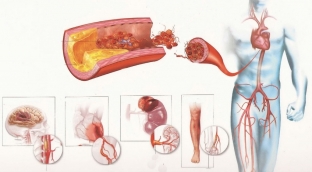Stress, a stressful lifestyle and modern low-quality food make many people aged after 45 years of chronic patients. Heart disease, vascular atherosclerosis and hypertension can have dangerous complications. Impaired cerebral circulation is one of the serious complications of these chronic pathologies and can be in the form of a transient ischemic attack or cerebral stroke. For effective treatment of such a complication, it is necessary to know what processes occur in the brain tissue when blood supply is disturbed. How does brain hypoxia develop in TIA?
What is a transient ischemic attack?
Transient ischemic attack is a reversible impairment of brain function. Unlike a stroke, a transient ischemic attack lasts up to 24 hours.
Such an attack could herald a cerebral stroke. Approximately one third of the patients who suffered an ischemic attack soon developed a cerebral stroke. The likelihood of developing a stroke depends on the age and condition of the patient.
The causes of transient ischemic attack are atherosclerotic lesions of the arteries, vascular damage against the background of arterial hypertension and hypertension itself, a combination of hypertension with atherosclerosis, heart diseases accompanied by cardiogenic thromboembolism.
Pathologies of the heart that can provoke a transient ischemic attack:
- Rheumatic affections of the heart.
- Atrial fibrillation and other arrhythmias.
- Myocardial infarction, development of post-infarction aneurysms.
- Cardiomyopathies, endocarditis of bacterial and non-bacterial nature.
- Calcifying aortic stenosis, mitral valve calcification.
- Congenital heart defects with septal defects, mitral valve prolapse.
What is the mechanism of development of transient ischemic attack? Stages of TIA
There is a direct relationship between cerebral hemodynamics and metabolic parameters. When cerebral perfusion pressure decreases, vasodilation (autoregulation) develops as the first compensatory response. Against this background, the volume of brain blood increases.
When the lower limit of autoregulation is reached, the cerebral blood supply begins to decrease. At this stage of cerebral ischemia, the intensity of oxygen exchange remains at the same level (oligemia). If the pressure continues to fall, the oxygen exchange decreases, which is manifested by the onset of the stage of true cerebral ischemia, which is accompanied by a violation of the activity of neurons.
This condition may eventually go away on its own, then it is called a transient ischemic attack, or develop further, having the name of a stroke. That is, there are 4 stages in the development of ischemia of a cerebral attack: autoregulation, oligemia, ischemic penumbra and irreversible damage, characteristic of a cerebral stroke.

What causes cerebral ischemia in transient ischemic attack?
With the development of a transient ischemic attack and hypoxia of the brain, the process of anaerobic glycolysis begins. Lactic acidosis develops, energy production drops sharply, lactate accumulates, followed by dilation and increased perfusion in the ischemic zone.
These processes negatively affect other processes, aggravating the metabolism of the brain tissue. There is a passive outflow of calcium, sodium, chlorine ions against the background of changes in the permeability of cell membranes and depolarization, water and free radicals accumulate inside the cell, lipid peroxidation becomes more intense. Such processes lead to cerebral infarction.
In an ischemic attack, cerebral edema and intracellular edema are inevitably formed due to the disruption of the sodium-potassium pump and the penetration of water inside the neurons. Vasogenic extracellular edema joins this edema against the background of damage to the blood-brain barrier. Vasogenic edema develops in the white matter of the brain. The severity of the edema depends on the state of the collateral circulation.
Thus, for the successful treatment of transient ischemic attack, in order to prevent the development of stroke, it is important to eliminate the causes and influence the chain of pathogenesis. To do this, drugs are used to reduce cerebral edema and improve cerebral circulation.







Add a comment